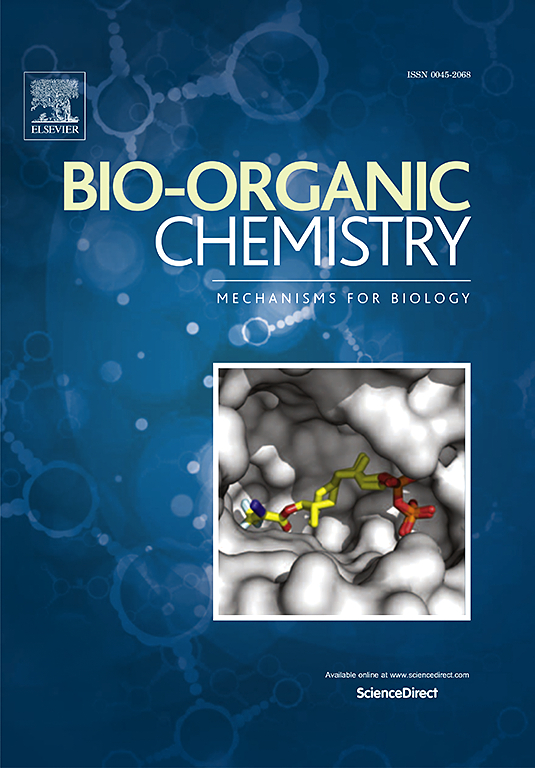将 4-取代的 2-苯基喹唑啉衍生物作为治疗阿尔茨海默病的多能配体的体外和体内研究。
IF 4.5
2区 医学
Q1 BIOCHEMISTRY & MOLECULAR BIOLOGY
引用次数: 0
摘要
阿尔茨海默病(AD)的病理复杂,由于其多因素的性质和单靶向药物被证明是无效的。设计并合成了一系列新型4- n -取代-2-苯基喹唑啉衍生物,作为潜在的多靶点定向配体(mtdl),通过双重抑制AChE和MAO-B酶以及抑制Aβ42聚集来治疗AD。该系列化合物VAV-8和VAV-19是AChE和MAO-B酶的最有效抑制剂和a - β42的中等抑制剂,在酶的结合袋处具有良好的热力学稳定性。这两种配体均表现出适度的ROS抑制和神经保护潜力,并被发现可渗透到血脑屏障。此外,我们还利用斑马鱼模型对VAV-8进行了毒性评估和体内研究。在成年斑马鱼中,VAV-8 (5 μM和10 μM)可有效减轻东莨菪碱诱导的认知衰退、神经变性和氧化应激。因此,这些喹唑啉衍生物有潜力开发为治疗阿尔茨海默病的mtdl。本文章由计算机程序翻译,如有差异,请以英文原文为准。

In vitro and in vivo Investigations of 4-Substituted 2-Phenylquinazoline derivatives as multipotent ligands for the treatment of Alzheimer’s disease
The pathology of Alzheimer’s disease (AD) is complex due to its multifactorial nature and single targeting drugs proved inefficient. A series of novel 4-N-substituted-2-phenylquinazoline derivatives was designed and synthesized as potential multi-target directed ligands (MTDLs) through dual inhibition of AChE and MAO-B enzymes along with Aβ42 aggregation inhibition for the treatment of AD. Two compounds in the series, VAV-8 and VAV-19 were found to be the most potent inhibitors of both AChE and MAO-B enzymes and moderate inhibitor of Aβ42, with good thermodynamic stability at the binding pocket of the enzymes. Both the ligands showed moderate ROS inhibition and neuroprotection potential and found to be permeable to the blood–brain barrier. Furthermore, VAV-8 was subjected to toxicity evaluation and in vivo investigation using a zebrafish model. In adult zebrafish, VAV-8 (5 μM, and 10 μM) was found to be effective in reducing cognitive deterioration, neurodegeneration, and oxidative stress induced by scopolamine. Thus, these quinazoline derivatives have the potential to be developed as MTDLs for the treatment of Alzheimer’s disease.
求助全文
通过发布文献求助,成功后即可免费获取论文全文。
去求助
来源期刊

Bioorganic Chemistry
生物-生化与分子生物学
CiteScore
9.70
自引率
3.90%
发文量
679
审稿时长
31 days
期刊介绍:
Bioorganic Chemistry publishes research that addresses biological questions at the molecular level, using organic chemistry and principles of physical organic chemistry. The scope of the journal covers a range of topics at the organic chemistry-biology interface, including: enzyme catalysis, biotransformation and enzyme inhibition; nucleic acids chemistry; medicinal chemistry; natural product chemistry, natural product synthesis and natural product biosynthesis; antimicrobial agents; lipid and peptide chemistry; biophysical chemistry; biological probes; bio-orthogonal chemistry and biomimetic chemistry.
For manuscripts dealing with synthetic bioactive compounds, the Journal requires that the molecular target of the compounds described must be known, and must be demonstrated experimentally in the manuscript. For studies involving natural products, if the molecular target is unknown, some data beyond simple cell-based toxicity studies to provide insight into the mechanism of action is required. Studies supported by molecular docking are welcome, but must be supported by experimental data. The Journal does not consider manuscripts that are purely theoretical or computational in nature.
The Journal publishes regular articles, short communications and reviews. Reviews are normally invited by Editors or Editorial Board members. Authors of unsolicited reviews should first contact an Editor or Editorial Board member to determine whether the proposed article is within the scope of the Journal.
 求助内容:
求助内容: 应助结果提醒方式:
应助结果提醒方式:


